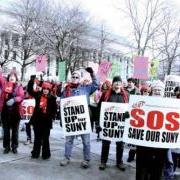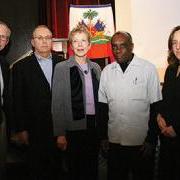|

The blare of police sirens echoed through Albany’s West Capitol Park, intruding on UUP President Phillip Smith’s impassioned call for action to more than 300 unionists at a rally to save SUNY from massive proposed state budget cuts. The irony wasn’t lost on Smith.
“Yeah, there are sirens,” he shouted over the din as the crowd cheered. “This is an emergency! We have to defeat these budget cuts. We have to defeat the so-called Public Higher Education Empowerment and Innovation Act. We cannot sacrifice SUNY.”
The Feb. 5 rally—attended by UUPers, members of New York State United Teachers (NYSUT) and the AFL-CIO, students and other SUNY supporters—was the latest in a series of UUP’s advocacy efforts to reverse Gov. David Paterson’s planned $153 million cut to SUNY. If approved, SUNY’s budget cuts would total $562 million over the last two years.
The rally wasn’t the only effort UUP made to fight the cuts.
UUP brought busloads of members and supporters from chapters across the state to Albany in January and February to urge legislators to save SUNY. On Jan. 26, the union’s largest Advocacy Day contingent—65 members and supporters—traveled to the Capitol to meet with legislators.
In February, the union kicked off a far-reaching television and Internet campaign opposing the budget cuts. The commercial will be shown across the state (see related story, page 6). UUP also launched SaveSUNY.org, a Web site to inform SUNY students, parents and the public about the impact of the planned state cuts.
The site includes a petition and letters to state lawmakers, and visitors to the site are urged to ask their e-mail contacts to also take action.
UUP’s chapters also mobilized. Members at Brockport, Cortland, Upstate Medical University in Syracuse, Plattsburgh, UAlbany, Purchase and the New York State Theatre Institute (NYSTI) have met with local legislators to spread the word that SUNY’s mission as an accessible, affordable higher education option for state students will be in jeopardy if the governor’s reductions aren’t derailed.
And the UUP Web site, www.uupinfo.org, has a series of letters members can fax to legislators calling for an end to SUNY budget cuts and the Act, to support the hospitals, and to save NYSTI.
“We’ve got to let the legislators and the governor know that the cuts the governor has planned for SUNY will hurt the citizens of New York,” said Winfield Ihlow, an Oswego delegate who marched in the rally.
The budget cuts aren’t the only battle UUP is fighting.
The union is also working to turn away Paterson’s so-called Public Higher Education Empowerment and Innovation Act. If passed, SUNY tuition could jump by as much as 10 percent next year. The “flex” plan—which Smith has dubbed the “Endangerment and Injury Act”—would allow colleges to unilaterally impose differential tuition at SUNY schools and limit legislative oversight.
NYSTI is in the governor’s cross-hairs; Paterson wants to eliminate state funding to NYSTI by 2011-12, forcing it to exist on ticket sales and donations. That’s impossible, Smith said. SUNY’s teaching hospitals and health science centers would be required to absorb $75 million in new mandatory costs and fringe benefits in Paterson’s budget proposal.
“Our message has been that in a time of economic downturn, people have the greatest need for education and affordable healthcare—the two things that Upstate Medical University does,” said UMU Chapter President Carol Braund. “We are united in spreading the word that the level of cuts being directed at SUNY is disproportionate to the cuts to all other areas of spending in the budget.”
Smith and the other speakers embraced that message at the rally, one of the largest in UUP history. Members and supporters—many of them from NYSTI—marched loudly on the park’s oval sidewalk, waving signs and chanting slogans such as “Hey hey, ho ho, budget cuts have got to go.”
Assemblyman John J. McEneny (D-Albany) told the crowd that it is wise during hard times for the state to invest in education and its young people.
“Our SUNY system was free at one time,” McEneny said. “How far we have sunk since then.”
UAlbany student Alex Naidoo thanked UUP for standing up for students. He said that he and many of his friends may be forced to drop out of school if the Empowerment Act were adopted and tuition soared.
“I think this is going to affect me personally and it’s going to affect tons of other students,” he said.
NYSUT Executive Vice President Andrew Pallotta applauded UUP for standing up to the cuts for the sake of K-12 students who are “still in the pipeline.” He urged the union to fight
Paterson, who he said was trying to “privatize” public higher ed. “What you’re doing here today is the right thing,” Pallotta said.
During his short speech, former NYSUT Executive Vice President Alan Lubin contrasted President Obama’s statements on the importance of higher education during his 2009 visit to Troy’s Hudson Valley Community College and Paterson’s penchant for slashing SUNY.
“We hear the president of the United States say how important higher education is and then we come home to Albany and hear our governor say it isn’t that important at all,” said Lubin, as the crowd roared its approval.
Smith, who railed at the budget cuts and picked apart the Empowerment Act, ended the rally by asking members to turn toward the Capitol and tell the governor “No!” The crowd responded by chanting “No more cuts!”
“Help me to tell this governor we’re not going to stand for it,” Smith said. “We’ve had enough cuts. You’re not going to abandon us.”
— Michael Lisi
|











